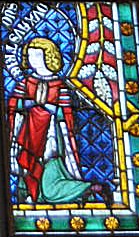Master of Königsfelden
The master of Königsfelden is a fictional artist hypothetically assumed by Emil Maurer who created the glass windows in the ambulatory of the monastery church of Königsfelden in the Swiss canton of Aargau . The eleven windows, painted for this double Franciscan monastery founded in 1308 , are considered to be important works of art in European stained glass of the 14th century. At least since the research of Brigitte Kurmann-Schwarz, which is based on the style-critical study of Gerhard Schmidt, it has been clear that the choir glazing was carried out in several stages between approx. 1325 and 1340 by several artists. Since then, people no longer speak of a master from Königsfelden, but of a Königsfeld workshop .
Image program
Despite the different hands, the cycle of stained glass in the ambulatory of Königsfelden shows a self-contained image program that shows a scene of the Passion and Resurrection in the center . Other windows depict the founders of the order, Francis of Assisi and Clare , surrounded by saints who were particularly venerated by the Franciscans , the Poor Clares or the family of the Habsburg founders of the monastery in Königsfelden. Small pictures of members of the founding family such as Albrecht II are given to some of the saints.
style
The glass pictures suggest an influence from the contemporary painting style of the Upper Rhine around Strasbourg and from the Lake Constance area around Constance. They are characterized by their spatiality and differentiated choice of colors. They show the development of art from high to late Gothic style. The style-critical investigations of details by Gerhard Schmidt and Brigitte Kurmann-Schwarz showed that several artists must have worked on the glazing, which was created over a period of around 10–15 years. This refuted Emil Maurer's assumption that only one artist was responsible for the execution (the so-called Meister von Königsfelden).
The outstanding quality with which the work was carried out, as well as the pictorial program, probably designed under the guidance of learned theologians, show the importance attached to the monastery church, as well as the high status of the monastery founders Elisabeth of Görz-Tirol and her daughter Queen Agnes of Hungary , Members of the German King Albrecht I, who was murdered in 1308 .
literature
- Brigitte Kurmann-Schwarz: The medieval glass paintings of the former monastery church in Königsfelden. Corpus Vitrearum Medii Aevi Switzerland, Volume 2.Stämpfli Verlag, Bern 2008.
- Gerhardt Schmidt: On the dating of the choir window of Königsfelden. In: Österreichische Zeitschrift für Kunst und Denkmalpflege 40, 1986, pp. 161–171.
- Emil Maurer : The art monuments of the canton of Aargau. Vol. 3: The Königsfelden Monastery. Verlag Birkhäuser, Basel 1954 (= Die Kunstdenkmäler der Schweiz, Vol. 32).
- Walter Merz: Guide through the monastery church Königsfelden. Sauerländer & Co., Aarau 1923.
Web links
Individual evidence
- ^ B. Kurmann-Schwarz: The medieval stained glass of the former monastery church in Königsfelden . Bern 2008, p. 183f .: "The choir glazing does not go back to a uniform planning, nor was it executed by the same glass painters. Rather, they were created in several stages, in which different artists were active."
| personal data | |
|---|---|
| SURNAME | Master of Königsfelden |
| BRIEF DESCRIPTION | Swiss artist of glass paintings |
| DATE OF BIRTH | 13th century or 14th century |
| DATE OF DEATH | 14th Century |

